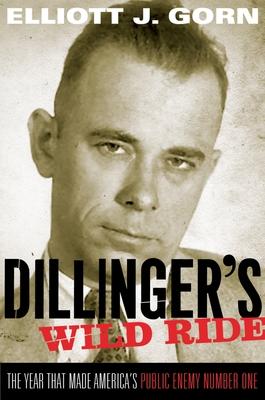In an era that witnessed the rise of celebrity outlaws like Baby Face Nelson, Pretty Boy Floyd, and Bonnie and Clyde, John Dillinger was the most famous and flamboyant of them all. Reports on the man and his misdeeds--spiced with accounts of his swashbuckling bravado and cool daring--provided an America worn down by the Great Depression with a salacious mix of sex and violence that proved irresistible.
In Dillinger's Wild Ride, Elliott J. Gorn provides a riveting account of the year between 1933 and 1934, when the Dillinger gang pulled over a dozen bank jobs, and stole hundreds of thousands of dollars. A dozen men--police, FBI agents, gangsters, and civilians--lost their lives in the rampage, and American newspapers breathlessly followed every shooting and jail-break. As Dillinger's wild year unfolded, the tale grew larger and larger in newspapers and newsreels, and even today, Dillinger is the subject of pulp literature, serious poetry and fiction, and films, including a new movie starring Johnny Depp. What is the power of his story? Why has it lingered so long? Who was John Dillinger? Gorn illuminates the significance of Dillinger's tremendous fame and the endurance of his legacy, arguing that he represented an American fascination with primitive freedom against social convention. Dillinger's story has much to tell us about our enduring fascination with outlaws, crime and violence, about the complexity of our transition from rural to urban life, and about the transformation of America during the Great Depression.
Dillinger's Wild Ride is a compulsively readable story with an unforgettable protagonist.

Dillinger's Wild Ride: The Year That Made America's Public Enemy Number One
In an era that witnessed the rise of celebrity outlaws like Baby Face Nelson, Pretty Boy Floyd, and Bonnie and Clyde, John Dillinger was the most famous and flamboyant of them all. Reports on the man and his misdeeds--spiced with accounts of his swashbuckling bravado and cool daring--provided an America worn down by the Great Depression with a salacious mix of sex and violence that proved irresistible.
In Dillinger's Wild Ride, Elliott J. Gorn provides a riveting account of the year between 1933 and 1934, when the Dillinger gang pulled over a dozen bank jobs, and stole hundreds of thousands of dollars. A dozen men--police, FBI agents, gangsters, and civilians--lost their lives in the rampage, and American newspapers breathlessly followed every shooting and jail-break. As Dillinger's wild year unfolded, the tale grew larger and larger in newspapers and newsreels, and even today, Dillinger is the subject of pulp literature, serious poetry and fiction, and films, including a new movie starring Johnny Depp. What is the power of his story? Why has it lingered so long? Who was John Dillinger? Gorn illuminates the significance of Dillinger's tremendous fame and the endurance of his legacy, arguing that he represented an American fascination with primitive freedom against social convention. Dillinger's story has much to tell us about our enduring fascination with outlaws, crime and violence, about the complexity of our transition from rural to urban life, and about the transformation of America during the Great Depression.
Dillinger's Wild Ride is a compulsively readable story with an unforgettable protagonist.